How to save on letters and postage, mid-20th century UK
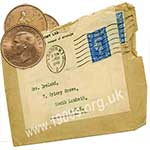
There were ways of saving postage costs, particularly during the austerity of the Second World War. This page explores economy labels for re-using envelopes, special lightweight airmail stationery and air-letters, also known as aerogrammes for combining envelope and letter to save weight. Illegal re-use of postage stamps is also included.
____
By the webmaster, based on firsthand recollections and discussions with older people
Economy labels for envelopes
During the Second World War and in the years of austerity afterwards, it was common to save on notepaper and reuse envelopes with what were called economy labels. These were cheap brown paper, gummed on the back and of a size and shape to stick round a used envelope and take the new address and postage stamp - see the following picture.
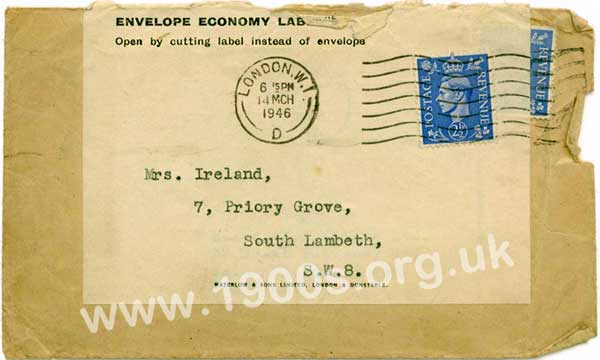
Economy label enabling a used envelope to be re-used, courtesy of Gwen Nelson. Incidentally note the lack of a modern postcode and that the address is clearly typed on an old manual typewriter.
How economy labels were used
When a letter was received, the envelope had to be split carefully along the top and not torn. Then, for the next use it was resealed with an economy label. These could be bought in packs from stationers.
Businesses, particularly those which sent out invoices requiring cheques or postal orders in payment often included economy labels for replies. These were ready printed with the return address and were often ready stamped or franked.
Economy labels were too lightweight to affect postage costs, which were by weight.
Postage by weight: air mail stationery for cheaper postage overseas
Air mail postage was expensive and priced by weight. So weight needed to be kept to a minimum. Hence the use of very lightweight paper, known as air mail stationery. Air mail stationery consisted of special flimsy envelopes and flimsy writing paper. Both were readily available in stationery outlets like W H Smiths. The air mail envelopes always seemed to have the British colours of red, white and blue round the edge.
Letters posted with this type of stationery needed to be weighed at the post office. Then the appropriate postage stamp needed to be bought and stuck on the envelope.
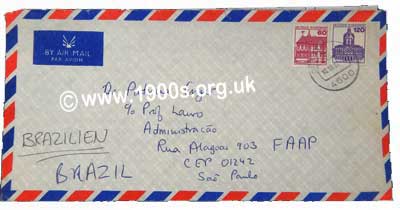
An air envelope for a letter
Incidentally mail to Australia and New Zealand normally went by sea in the early days because the cost of air mail was prohibitally expensive. But sea mail took a very long time - six weeks for Australia. This meant that the time from sending to receiving a reply took at least three months! I always remember my utter amazement years later when I emailed Australia and got a reply the same day! Now communication is instant with video calls, and everyone regards it as quite normal.
Air letters, aerogrammes
Air letters, also called aerogrammes, were sold by the Post Office to include postage. They could be bought unweighed in batches because they were all of a standard known weight which enabled them to be ready franked. They were printed with a look-alike stamp and the air mail logo. They were always blue.
They were single longish sheets of flimsy paper which served as letters and envelopes combined. When folded into three and stuck down, they looked just like an envelope.
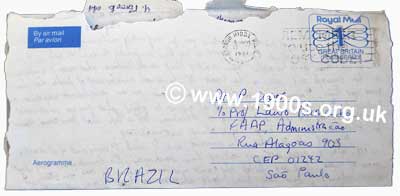
An air letter folded in three as for transit
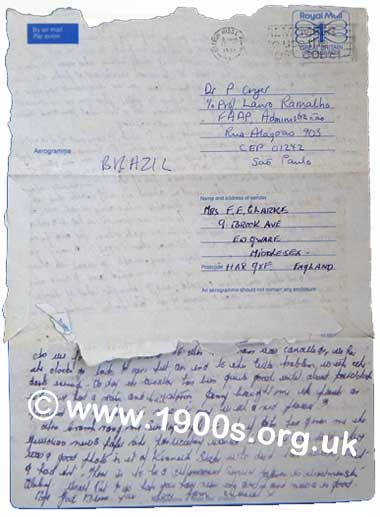
One side of an opened air letter. Part of this side and all of the other side were for correspondence.
Illegal reuse of postage stamps
The glue used for stamps was the sort that had to be dampened to stick. This meant that used stamps could be soaked in water making the glue dissolve and the stamp float to the surface. This was not only useful for stamp collecting. It also meant that if a stamp had missed the franking machine, which wasn't entirely unusual, it could be reused by gluing it onto a new envelope. Needless to say, this wasn't ethical, but I don't know if there was any law making it illegal.
| sources | webmaster | contact |
Text and images are copyright
If you can add anything to this page or provide a photo, please contact me.



